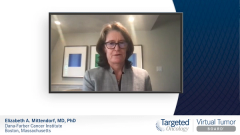
Case 2: 34-Year-Old Woman With TNBC
Elizabeth Mittendorf, MD, PhD, presents the case of a 34-year-old woman with PD-L1–positive triple-negative breast cancer.
Episodes in this series

Elizabeth A. Mittendorf, MD, PhD: Our second case is a 34-year-old woman who presented with a palpable breast mass and mild back pain. That breast mass tissue was biopsied, and it showed a poorly differentiated invasive ductal carcinoma. That was triple-negative breast cancer. Germline staging PET [positron emission tomography] scan and FDG [F-fluorodeoxyglucose] avid lesions were identified in the bone, the lung, and the mediastinal nodes. She had routine chemistries in other labs performed, and they were generally within normal limits, although there was a slight elevation in ALK-phosphatase. She underwent a biopsy of the lung to confirm the metastatic disease, and similar our previous case, it was subject to PD-L1 testing. But in this case, it was PD-L1 negative. She didn’t have a strong family history, but given her young age and the triple-negative breast cancer, it was counsel to undergo genetic counseling or genetic testing. In fact, her germline testing was positive for a BRCA pathogenic variant. Before we jump into details about how we might address this patient, David, could you briefly discuss what germline testing is vs somatic testing? What differences are we looking for?
David G. Hicks, MD: Germline testing would be looking in the blood. A germline mutation carrier essentially has that mutation in every cell of their body. So you could pick it up in a blood sample. Somatic mutation testing would be a mutation acquired in the tumor during the development of the tumor. Particularly, triple-negative breast cancers carry lots of somatic mutations. More and more we’re being asked to do next-generation sequencing on tumors, and whole-genome sequencing, more commonly known as a solid tumor panel. A solid tumor panel is where we have 81 potential genes of interest in which we look for in the tumor.
That can be done out of paraffin-embedded tissue blocks from the pathology lab. There are implications for both. In the future, we may be seeing genetic testing on every patient with metastatic breast cancer and somatic mutation testing on many of the tumors.
Elizabeth A. Mittendorf, MD, PhD: Yeah. Before we jump into this specific case—I told you this patient is a BRCA mutation carrier, so that’s clearly going to direct the therapy we’re going to recommend—Ruta, what’s your practice for evaluating patients with breast cancer for genetic counseling, or genetic testing in general? What are you guys doing at Rush University Medical Center in Chicago?
Ruta Rao, MD: For anybody who’s age 60 or less with a new diagnosis of triple-negative breast cancer, whether it’s metastatic or early stage, we do refer for genetic testing. In addition, we also do this for patients with strong family histories. We have a genetic counselor on all our tumor boards so that we can always ask the question: Do you think this patient would be a candidate for genetic testing? Specifically, for these patients with metastatic triple-negative breast cancer, it’s important to think about testing all of them because we do have a targeted therapy that we know has some benefit in patients who have the germline BRCA1 or BRCA2 mutations. We don’t want to miss that potential patient. This patient was very appropriately tested for it, but I would consider testing almost anybody who’s metastatic triple-negative for the germline mutations.
Elizabeth A. Mittendorf, MD, PhD: This is going a tangent, but I ask because we’re seeing this in our practice. A couple of years ago, the American Society of Breast Surgeons put out a recommendation that everybody with breast cancer should have genetic testing. What are your thoughts on that?
Ruta Rao, MD: We do have a little trouble getting some patients’ genetic testing covered, so a piece of it: the financial piece. We don’t want to add to the financial toxicity these patients are going through, especially if their family history is not suggestive of it. But yes, that recommendation is out there. That’s 1 of those things that we’ll all have to keep our eyes on in the years to come. It may end up being that we test every patient with breast cancer for germline mutations.
Elizabeth A. Mittendorf, MD, PhD: You said it was appropriate. I suggest having this specific patient tested for our mutation. I suspect you said that because this patient has a BRCA mutation, so it actually is going to impact your treatment recommendations. If we look at the slides we’ve pulled together for this case, the first slide shows the 2 phase 3 studies that have been completed looking at PARP inhibitors and patients who carry a BRCA1- or BRCA2-mutated metastatic breast cancer. The 2 trials are OlympiAD and EMBRACA. OlympiAD looked at the agent olaparib. EMBRACA looked at the agent talazoparib. If we look at the next slide, the first 1 being the schema, and the second slide being the results of the studies. For both trials, the primary end point was looking at progression-free survival. What we see is that there was a benefit with respect to giving the PARP inhibitor vs chemotherapy of physician’s choice. The third slide that we have for this case is looking at the extended follow-up—specifically for the OlympiAD trial, which was looking at olaparib. We see that for the overall population, the median overall survival was 19.3 months vs about 17 months. There’s no statistically significant difference in survival in the overall population. Also, there were no new safety signals with this more extended follow-up. But we do have some interesting data when you think about whether a patient had prior chemotherapy. I’m going to stop my comments there and ask you: Given the data from OlympiAD and EMBRACA, how are you going to treat this young woman in our case?
Ruta Rao, MD: We would ideally like to start with a PARP inhibitor in a patient like this. She is chemotherapy-naïve. We did see that her tumor tested negative for PD-L1 via the SP142 assay. We’re not really thinking about immunotherapy in this patient, although I do have a question for David: Is this the kind of patient for whom, because she was tested with the SP142 and was negative, you would recommend that her tumor be retested with the 22C3?
David G. Hicks, MD: I think so. Particularly if the option of treating with pembrolizumab was a potential part of her therapy. About 30% of patients will be negative for SP142 but positive for 22C3, so it’s possible that it could be positive. That’s what we’re hearing from our medical oncologists, our institution. If 1 is negative, then please test for the other 1.
Ruta Rao, MD: In our practice, we would do the same. Back to this patient. Even if we assume that she’s tested via both assays for PD-L1 and is negative, a PARP inhibitor would be a great choice for her because the overall survival was greater for those patients who had not received prior chemotherapy.
Elizabeth A. Mittendorf, MD, PhD: That was the finding on that last slide that we showed. In the OlympiAD trial, for patients who had no prior chemotherapy, the median overall survival was about 23 months for those getting olaparib vs about 15 months for those getting chemotherapy. The EMBRACA study—the last slide in this set for this patient—doesn’t appear to show that there’s a statistically significant difference in overall survival. The 2 trials are so similar, yet they’re a little different. How do you put the data together to determine whether you’re going to give olaparib vs talazoparib?
Ruta Rao, MD: That’s a tough question. Clearly, the drugs have not been compared head-to-head. Some of it is: What have you used before? What are you more comfortable using? What are you more comfortable managing the adverse effects of? Both drugs have strong phase 3 data and approval in this setting.
Transcript edited for clarity.














































